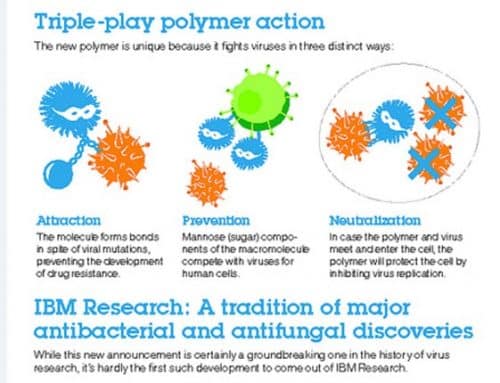The new research makes use of supramolecular chemistry - the study of extremely large molecules designed in a way that combines several properties and abilities into a single molecule - for the tasks of fighting viral infection. The research is apparently the first of its kind in regards to the fight against viral diseases and IBM's cognitive computing system, Watson, is even expected to help and speed up the drug discovery process.

Viral diseases present one of the greatest challenges to the world of medicine, due to the ability of the viruses that cause them to evade vaccines and quickly develop drug resistance. Many viruses, such as Zika, Ebola and dengue fever, have become a worldwide epidemic with a heavy human and economic toll. Scientists at IBM and the Singapore Research Institute for Biological Engineering and Nanotechnology have identified a macromolecule that may help prevent life-threatening viral infection, using a three-step mechanism of action that prevents the virus from developing drug resistance.
The new research makes use of supramolecular chemistry - the study of extremely large molecules designed in a way that combines several properties and abilities into a single molecule - for the tasks of fighting viral infection. The research is apparently the first of its kind in regards to the fight against viral diseases and IBM's cognitive computing system, Watson, is even expected to help and speed up the drug discovery process.
A three-step activity to prevent the development of drug resistance
The new macromolecule combines a series of dedicated components that create a three-step activity in the fight against viral infection and virus replication - while curbing the danger of developing drug resistance.
In the stage of attachment to the virus (Attraction), a special part of the molecule is used to build strong hydrogen bonds that maintain an electrostatic interaction, and attract proteins found on the surface of the virus envelope. Thus, the ability of viral infection and damage to healthy cells is inhibited.
In the Prevention phase, Mannose components - a type of sugar incorporated into a macromolecule - are used to contact directly the receptors of healthy cells in the immune system, in order to help fight the viral infection and allow the free flow of these natural defense cells.
In the neutralization phase, another component of the molecule, known as basic amine groups, acts to neutralize the acidity level (pH) inside the viral cell, making it unfriendly to replication processes.
In addition, the research aims to design extremely flexible macromolecules, while examining a wide variety of viruses in different categories, including Ebola, Dengue, Marburg, Influenza, Chikungunya, Enterovirus 71 and Herpes Simplex. In the first tests, no development process of drug resistance was observed. The simultaneous focus, both on the proteins that make up the virus and on the interactions of the virus with the environment and on its replication processes, inhibits the normal process of the appearance of new mutations, which allow the virus to escape vaccines through the development of resistance.
According to Dr. James Hedrick, the principal researcher in the field of advanced organic materials at the IBM research laboratory in Elmden, California, "the recent outbreaks of viruses such as Zika and Ebola, increase the importance of achieving breakthroughs in the antiviral field. The new approach presents exciting possibilities and IBM is now interested in collaborating with universities and other organizations in order to identify new applications of this technology."
Disease fighting potential
In the near term, IBM's new technology shows potential for applications such as an antiviral cleaning agent, which may include a minimal amount of macromolecules to be dissolved in water, in order to neutralize an entire room infected with, for example, Ebola. Potential applications in the longer term may include the development of new vaccines to help prevent entire categories of viral diseases.
IBM's cognitive computing tools may continue to advance current research. Thus, for example, when the macromolecule advances to the clinical trial stage, the Watson Discovery Advisor system will be able to identify relationships between different data, in order to speed up the process of generating new insights. The Watson system for clinical trials improves the ability of doctors to locate clinical trials suitable for the patient in front of them, and to increase the likelihood of offering the appropriate treatment option to patients, while improving the recruitment rate of suitable patients for each trial.
The full study, Cooperative Orthogonal Macromolecular Assemblies with Broad Spectrum Antiviral Activity, High Selectivity, and Resistance Mitigation, was recently published in the scientific journal Macromolecules.
